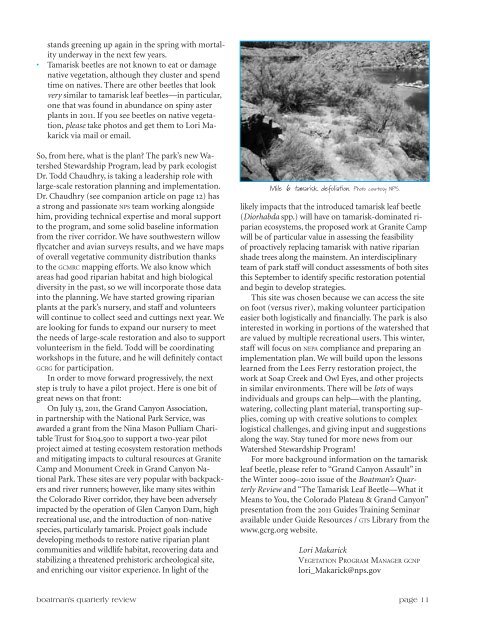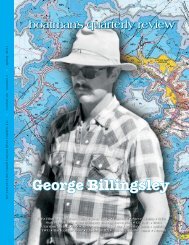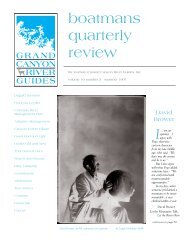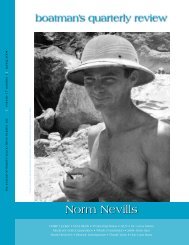fall 11 / 24:3 - Grand Canyon River Guides
fall 11 / 24:3 - Grand Canyon River Guides
fall 11 / 24:3 - Grand Canyon River Guides
- No tags were found...
Create successful ePaper yourself
Turn your PDF publications into a flip-book with our unique Google optimized e-Paper software.
stands greening up again in the spring with mortalityunderway in the next few years.• Tamarisk beetles are not known to eat or damagenative vegetation, although they cluster and spendtime on natives. There are other beetles that lookvery similar to tamarisk leaf beetles—in particular,one that was found in abundance on spiny asterplants in 20<strong>11</strong>. If you see beetles on native vegetation,please take photos and get them to Lori Makarickvia mail or email.So, from here, what is the plan? The park’s new WatershedStewardship Program, lead by park ecologistDr. Todd Chaudhry, is taking a leadership role withlarge-scale restoration planning and implementation.Dr. Chaudhry (see companion article on page 12) hasa strong and passionate nps team working alongsidehim, providing technical expertise and moral supportto the program, and some solid baseline informationfrom the river corridor. We have southwestern willowflycatcher and avian surveys results, and we have mapsof overall vegetative community distribution thanksto the gcmrc mapping efforts. We also know whichareas had good riparian habitat and high biologicaldiversity in the past, so we will incorporate those datainto the planning. We have started growing riparianplants at the park’s nursery, and staff and volunteerswill continue to collect seed and cuttings next year. Weare looking for funds to expand our nursery to meetthe needs of large-scale restoration and also to supportvolunteerism in the field. Todd will be coordinatingworkshops in the future, and he will definitely contactgcrg for participation.In order to move forward progressively, the nextstep is truly to have a pilot project. Here is one bit ofgreat news on that front:On July 13, 20<strong>11</strong>, the <strong>Grand</strong> <strong>Canyon</strong> Association,in partnership with the National Park Service, wasawarded a grant from the Nina Mason Pulliam CharitableTrust for $104,500 to support a two-year pilotproject aimed at testing ecosystem restoration methodsand mitigating impacts to cultural resources at GraniteCamp and Monument Creek in <strong>Grand</strong> <strong>Canyon</strong> NationalPark. These sites are very popular with backpackersand river runners; however, like many sites withinthe Colorado <strong>River</strong> corridor, they have been adverselyimpacted by the operation of Glen <strong>Canyon</strong> Dam, highrecreational use, and the introduction of non-nativespecies, particularly tamarisk. Project goals includedeveloping methods to restore native riparian plantcommunities and wildlife habitat, recovering data andstabilizing a threatened prehistoric archeological site,and enriching our visitor experience. In light of theMile 6 tamarisk defoliation. Photo courtesy NPS.likely impacts that the introduced tamarisk leaf beetle(Diorhabda spp.) will have on tamarisk-dominated riparianecosystems, the proposed work at Granite Campwill be of particular value in assessing the feasibilityof proactively replacing tamarisk with native riparianshade trees along the mainstem. An interdisciplinaryteam of park staff will conduct assessments of both sitesthis September to identify specific restoration potentialand begin to develop strategies.This site was chosen because we can access the siteon foot (versus river), making volunteer participationeasier both logistically and financially. The park is alsointerested in working in portions of the watershed thatare valued by multiple recreational users. This winter,staff will focus on nepa compliance and preparing animplementation plan. We will build upon the lessonslearned from the Lees Ferry restoration project, thework at Soap Creek and Owl Eyes, and other projectsin similar environments. There will be lots of waysindividuals and groups can help—with the planting,watering, collecting plant material, transporting supplies,coming up with creative solutions to complexlogistical challenges, and giving input and suggestionsalong the way. Stay tuned for more news from ourWatershed Stewardship Program!For more background information on the tamariskleaf beetle, please refer to “<strong>Grand</strong> <strong>Canyon</strong> Assault” inthe Winter 2009–2010 issue of the Boatman’s QuarterlyReview and “The Tamarisk Leaf Beetle—What itMeans to You, the Colorado Plateau & <strong>Grand</strong> <strong>Canyon</strong>”presentation from the 20<strong>11</strong> <strong>Guides</strong> Training Seminaravailable under Guide Resources / gts Library from thewww.gcrg.org website.Lori Makarickvegetation Program Manager gcnplori_Makarick@nps.govboatman’s quarterly review page <strong>11</strong>
















